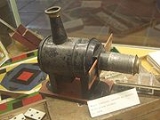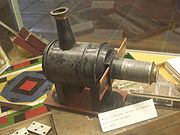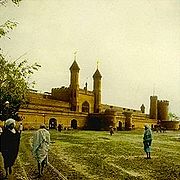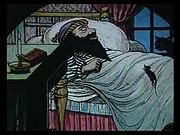
Magic lantern
Encyclopedia



Image projector
An image projector is an optical device that projects an image onto a surface, commonly a projection screen.Most projectors creates an image by shining a light through a small transparent image, but some newer types of projectors can project the image directly, by using lasers...
developed in the 17th century.
Operation
The magic lantern has a concave mirror in front of a light source that gathers light and projects it through a slide with an image scanned onto it. The light rays cross an aperture (which is an opening at the front of the apparatus), and hit a lens. The lens throws an enlarged picture of the original image from the slide onto a screen. Main light sources used during the time it was invented in the late 16th century were candles or oil lamps. These light sources were quite inefficient and produced weak projections. The invention of the Argand lampArgand lamp
The Argand lamp is home lighting oil lamp producing a light output of 6 to 10 candlepower which was invented and patented in 1780 by Aimé Argand...
in the 1790s helped to make the projected images brighter. The invention of the limelight
Limelight
Limelight is a type of stage lighting once used in theatres and music halls. An intense illumination is created when an oxyhydrogen flame is directed at a cylinder of quicklime , which can be heated to 2572 °C before melting. The light is produced by a combination of incandescence and...
in the 1820s made it even brighter, and following that the inventions of the electric arc lamp
Arc lamp
"Arc lamp" or "arc light" is the general term for a class of lamps that produce light by an electric arc . The lamp consists of two electrodes, first made from carbon but typically made today of tungsten, which are separated by a gas...
in the 1860s, and then incandescent electric lamps all further improved the projected image of the magic lantern. It was also an important invention for the motion picture film and 45mm projector because of its ability to screen moving images. To achieve this, mechanical slides were used to make the images move. This was done using two glass slides, one with the part of the picture that would remain stationary and one with the part of the picture that would move on a disc. The glass slides were placed one on top of the other in an orderly fashion and a hand-operated pulley wheel was used to turn the movable disc. The magic lantern also led directly to Eadweard Muybridge
Eadweard Muybridge
Eadweard J. Muybridge was an English photographer who spent much of his life in the United States. He is known for his pioneering work on animal locomotion which used multiple cameras to capture motion, and his zoopraxiscope, a device for projecting motion pictures that pre-dated the flexible...
's invention of the zoopraxiscope
Zoopraxiscope
The zoopraxiscope is an early device for displaying motion pictures. Created by photographic pioneer Eadweard Muybridge in 1879, it may be considered the first movie projector. The zoopraxiscope projected images from rotating glass disks in rapid succession to give the impression of motion. The...
, which was another forerunner for moving pictures.
History
There has been some debate about who the original inventor of the magic lantern is, but the most widely accepted theory is that Christiaan Huygens developed the original device in the late 1650s. In the fifteenth century, however, Giovanni FontanaGiovanni Fontana (engineer)
Giovanni Fontana was a fifteenth-century Venetian physician and engineer who portrayed himself as a magus. He was born in Venice in the 1390s and attended the University of Pauda, where he received a his degree in arts in 1418 and his degree in medicine in 1421. University records list him as...
, a Venetian engineer, had already created a lantern that projected an image of a demon. And other sources give credit to the German priest Athanasius Kircher
Athanasius Kircher
Athanasius Kircher was a 17th century German Jesuit scholar who published around 40 works, most notably in the fields of oriental studies, geology, and medicine...
. He describes a device such as the magic lantern in his book Ars Magna Lucis et Umbrae. There are possible mentions of this device associated with Kircher as early as 1646. Even in its earliest use, it was demonstrated with monstrous images such as the Devil. Huygens's device was even referred to as the "lantern of fright" because it was able to project spooky images that looked like apparitions. In its early development, it was mostly used by magicians and conjurers to project images, making them appear or disappear, transform from one scene into a different scene, animate normally inanimate objects, or even create the belief of bringing the dead back to life.
In the 1660s, a man named Thomas Walgensten used his so-called "lantern of fear" to summon ghosts. These misuses of this early machine were not uncommon. In fact, a common setup of the machine was to keep parts of the projector in a separate, adjoining room with only the aperture visible, to make it seem more magical and scare people. By the 18th century, use by charlatans was common for religious reasons. For example, Count Cagliostro used it to "raise dead spirits" in Egyptian masonry. Johann Georg Schröpfer
Johann Georg Schröpfer
Johann Georg Schröpfer was a German illusionist, freemason, and occultist. He was a pioneer of entertainment séances, being one of the first people to use a magic lantern to project the appearance of ghosts...
used the magic lantern to conjure up images of dead people on smoke. He staged routines doing this at his coffee shop in Leipzig. He did this to scare people and make them think he was a good actor. Schröpfer ended up going crazy and thinking he himself was pursued by real devils, and shot himself after promising an audience he would later resurrect himself.
Phantasmagoria
The later part of the 18th century was the age of Romanticism and the Gothic novel. There was an obsession with the bizarre and the supernatural. Johann Georg SchröpferJohann Georg Schröpfer
Johann Georg Schröpfer was a German illusionist, freemason, and occultist. He was a pioneer of entertainment séances, being one of the first people to use a magic lantern to project the appearance of ghosts...
began using the magic lantern in séance
Séance
A séance is an attempt to communicate with spirits. The word "séance" comes from the French word for "seat," "session" or "sitting," from the Old French "seoir," "to sit." In French, the word's meaning is quite general: one may, for example, speak of "une séance de cinéma"...
s, before Paul Philidor
Paul Philidor
Paul Philidor , also known as Paul de Philipsthal, was a German performer of entertainment séances in the style that would soon become known as phantasmagoria...
refined the techniques. In these shows, the illusionists used the magic lantern to trick people into thinking that they had summoned up spirits of revolutionary figures with the lantern mounted on a trolley. They also summoned ghosts by requests. However, Philidor's show was eventually closed by the authorities due to their paranoia. The audiences of these magic lantern shows reacted to the projections with bewilderment. They thought the projections were real dreams, visions, apparitions and ghosts, and the devil. This was just fueled by the fact that this is exactly what the early conjurers and magicians used them for: scaring people using these ghostly images.
The next famous conjurer to utilize the magic lantern was Etienne-Gaspard Robert
Étienne-Gaspard Robert
Étienne-Gaspard Robert , often known by the stage name of "Robertson", was a prominent Belgian stage magician and influential developer of phantasmagoria. He was described by Charles Dickens as "an honourable and well-educated showman"...
.
He was a Belgian inventor with an interest in magic. He held his first "fantasmagorie" at Pavillon de l'Echiquier in Paris. He began experimenting in the 1780s with techniques used to make phantasmagorias, which is basically the use of the magic lantern to conjure up supernatural images such as the devil, phantoms, or ghosts. If the images were projected onto a gauze screen, they would even seem to be floating in air, making the stunt even more believable-looking. At Pavillon de l'Echiquier, Robertson set up a public phantasmagoria and told the audience he would conjure up their dead relatives. He made a big show out of it and conjured up an image of a phantom with a dagger, and then pictures of the dead relatives. After this show, he continued to make other, bigger, more outrageous spectacles. He put the magic lantern onto wheels and patented this under the name of 'fantascope'. He eventually moved his work to a theater, where he built up a show to a big finale in which big shapes moved around the otherwise dark theater. Robertson also used mechanical slides to make his images move. There is a small collection of transparencies at Conservatoire National des Arts et Métiers in Paris which shows a two-piece slide he used with one glass showing the face of a phantom and the other which had the image of the eyes, which when used meant the eyes could roll back and forth. Also, Robertson used multiple lanterns to project both a moving figure as well as a background for that figure. For example, a stationary projector in the front would have projected an image of a church courtyard while a moving projector from behind would project the image of the phantom The Bleeding Nun, an image which came from the novel The Monk
The Monk
The Monk: A Romance is a Gothic novel by Matthew Gregory Lewis, published in 1796. It was written before the author turned 20, in the space of 10 weeks.-Characters:...
by Matthew Gregory Lewis
Matthew Gregory Lewis
Matthew Gregory Lewis was an English novelist and dramatist, often referred to as "Monk" Lewis, because of the success of his classic Gothic novel, The Monk.-Family:...
. His shows were extremely successful.
The popularity increased and eventually this phenomenon moved to England. Many observers have been quoted saying these "ghosts" were very realistic, which is partly due to people's eyes not being trained to the phenomenon of photography and cinematography like ours today are.
More recent uses
Eventually, the magic lantern came to America. It continued to be used by magicians but also to project moving images for entertainment. There were even some examples of pornographic striptease slides starting in the 1920s and proceeding into the first half of the 20th century. Today, the magic lantern is primarily only used by collectors. Collector Pierre Albanese and Thomas BlochThomas Bloch
Thomas Bloch is a classical musician specializing in the rare instruments ondes Martenot, glass harmonica, and Cristal Baschet....
, a musician specialist of rare instruments (the glass harmonica
Glass harmonica
The glass harmonica, also known as the glass armonica, bowl organ, hydrocrystalophone, or simply the armonica , is a type of musical instrument that uses a series of glass bowls or goblets graduated in size to produce musical tones by means of friction The glass harmonica, also known as the glass...
which was originally used in Phantasmagoria during the 18th and 19th centuries, cristal Baschet
Cristal baschet
The Cristal Baschet is a musical instrument that produces sound from oscillating glass cylinders. The Cristal Baschet is also known as the Crystal Organ and the Crystal Baschet, and composed of 54 chromatically-tuned glass rods. The glass rods are rubbed with moistened fingers to produce vibrations...
, ondes Martenot
Ondes Martenot
The ondes Martenot , also known as the ondium Martenot, Martenot and ondes musicales, is an early electronic musical instrument invented in 1928 by Maurice Martenot. The original design was similar in sound to the theremin...
, nail violin
Nail violin
The nail violin is a musical instrument which was invented by German violinist Johann Wilde in 1740. Wilde was inspired to create the instrument when he accidentally drew his bow across a metal peg, which produced a musical sound...
also originally used...) have premiered a live Magic Lantern show in 2008 which tours since this date.
See also
- Projector (disambiguation) for a directory of projector types
- ZoopraxiscopeZoopraxiscopeThe zoopraxiscope is an early device for displaying motion pictures. Created by photographic pioneer Eadweard Muybridge in 1879, it may be considered the first movie projector. The zoopraxiscope projected images from rotating glass disks in rapid succession to give the impression of motion. The...
- FilmFilmA film, also called a movie or motion picture, is a series of still or moving images. It is produced by recording photographic images with cameras, or by creating images using animation techniques or visual effects...
- PhantasmagoriaPhantasmagoriaPhantasmagoria can refer to:* Phantasmagoria, a type of show using an optical device to display moving images* Phantasmagoria, a video game* Phantasmagoria: A Puzzle of Flesh, a video game sequel to Phantasmagoria...
External links
- magic-lantern.eu website with more than 5200 lantern slides online
- Cinema and its Ancestors: The Magic of Motion Video interview with Tom Gunning
- A live Magic Lantern performance with accompaniment of crystal instruments is proposed here – feat. Pierre Albanese and Thomas BlochThomas BlochThomas Bloch is a classical musician specializing in the rare instruments ondes Martenot, glass harmonica, and Cristal Baschet....
- Live Magic Lantern Shows The American Magic Lantern Theater
- Magic Lantern – A School of Cinema Film Institute Chennai
- University of Tasmania Library Lantern Slide Collection

